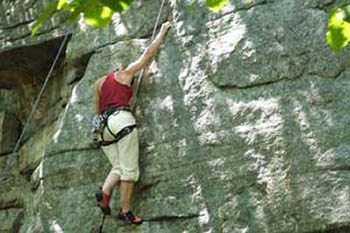
The Art of Not Doing: The Red Centre, Northern Territory, Australia
By Richard Bangs
In the eager pool of morning light, there rises The Rock. It is perhaps the most iconic symbol of the implacable indifferences of inhospitable landscapes, its dimensions timeless, unsummarized. And I want to climb it.
There is something in the Western mindset that arouses a nearly irresistible urge to climb a peak. We look up, we admire, and if possible, we act. It may be related to a primal impulse to conquer a headland, to be king of the hill, surveying all below.
And so we tread upwards, by sandal, sedan chair, boot, crampon, funicular, escalator, elevator, téléphérique, gondola, train, whatever — resistance is futile. The summit result is a near narcotic of validation, accomplishment, exhilaration, pride, and joy, coupled with a grand view.

Uluru, née Ayers Rock to those of a Western bent, beckons, it cries to be climbed. It has dark water stains streaking down its sides, looking like tears. I first leaned towards its astonishing red face while watching a 1978 John Denver special, in which he performed on top of The Rock. Wow. What it must be like to up there, with all the world spread below.
I’ve ascended hills and mountains around the world. Yet now, I am at the base of the famous inselberg, watching dots of people making their way up the chained scar-like path to the mighty view. But, I am not doing that.
“You Have to Climb the Rock!”
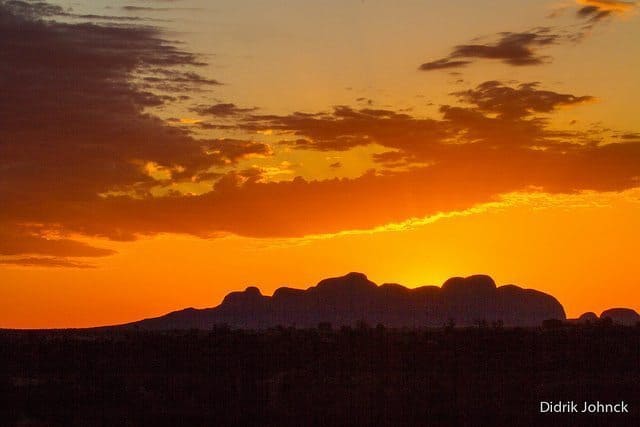
The airline counter woman in Sydney, when she saw the ticket to Ayers Rock, said “Oh, you have to climb The Rock! It is fabulous!” But I am not doing that. (Note: A flight to Uluru is three hours 40 minutes. Driving from Sydney is a very dusty 30 hours. If you prefer to drive, find a vehicle suitable for the outback conditions.)
When the Uluru-Kata Tjuta National Park was handed back to the Anangu Aboriginal tribe in 1985 one of the conditions was that the climb remain open. It’s popular and brings touro-dollars to the region. But that doesn’t prevent the Anangu from posting signs and making personal pleas urging visitors to stay at the bottom. Even the entry ticket to the Uluru-Kata Tjuta National Park entreaties to not do the climb.
Not to do the Climb
And so against instinct and aspiration, I vow to not do the climb. And that decision liberates a different level of awareness and adventure, it pricks the pleasure zones that come from restraint, reflection, and respect. Yes, I can forgo the physical overthrow and instead climb a spiritual plateau. But I have the itch to move, and so discover a whole host of alternative things to do here in the Red Centre of Australia.
I begin with a sail on a ship of the desert. It turns out there are more wild camels in Australia than anyplace in the world. They were imported in the 19th century from the Afghanistan region to help lay the telegraph line that would connect the antipodean to the world.

They helped lay the first rail ties. But they built the tracks to their own obsolescence, as with trains and roads they were no longer needed, and the government asked the Afghani cameleers to kill the beasts. They refused, and the camels went feral. Today estimates vary from 500,000 to a million camels on the loose in the Outback.
Uluru Camel Tours
I arrive at Uluru Camel Tours to the sounds of old men snorting and humphing — the 60-some camels out back are grazing some sere scrub before the next ride (“Book early for a good looking one,” says the brochure.) They are very tall, with impossibly long and knobby legs and a cavalier look.
Mark Swindells, the co-owner, ushers me to Daisy. Mark instructs Daisy to kneel, her front legs doubling over until they touch the ground. I throw one leg over her arched back, and grab the pommel bar with both hands.
Daisy makes a sound like a Wookie, then does her boat-rock rise, and I look down at her feet. They are big, round, splayed and padded, swollen looking, soft and squishy, like giant cat paws without the nails.
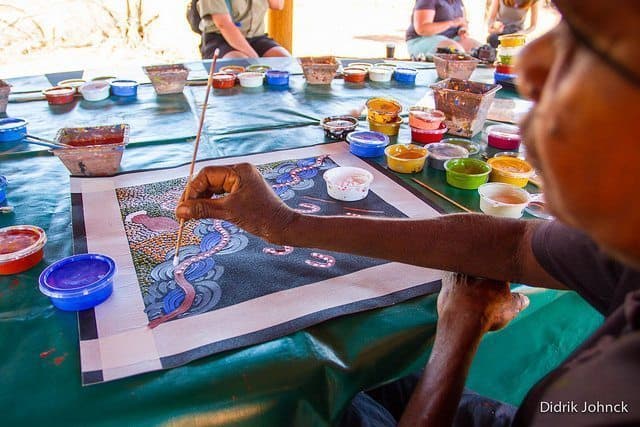
We turn by the spinning sails of the wind-pump and head in the direction of Uluru. Daisy gaits along with no hint of a hurry, even though this is rush hour in the Outback.
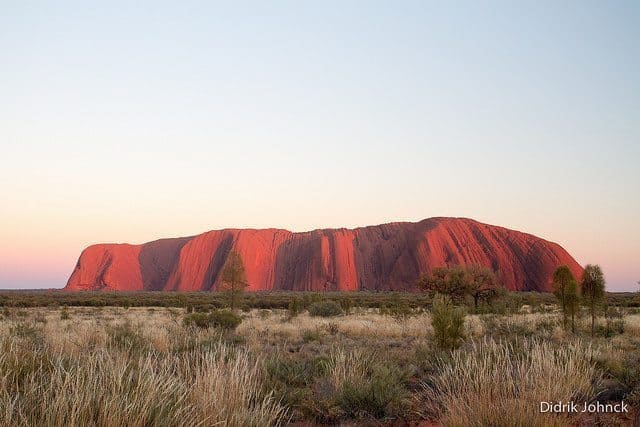
Back home, in Los Angeles, at this hour I am often stuck in traffic, choked not merely with pollution, but with the emissions of haste, rage, and cell towers. Here there is none of that nonsense. At one point Daisy curves her long neck back on itself and we exchange glances; she almost seems to be flirting with her glistening bulb-eyes…I can’t help but notice she seems to have large French eyelashes…quite seductive…. but British teeth.
We pause on a hill to watch the sun set fire to Uluru, and after a time Mark says it’s time to return. With her saddle creaking, Daisy lashes me back and forth in a movement a bit like Latin dancing as we gambol down the hill.
I stay at the Aborigine-owned Sails in the Desert Hotel, a full-service resort that springs like an oasis from the soft rufescent sands. But it’s an early tuck-in, because the first light can’t be missed in these parts.
At the Viewing Platform
By 5:30 am I’m at the viewing platform on the western side of Kata Tjuta, slapping my upper arms, wishing I had brought warmer clothing. But thoughts of the cold evaporate as the first rays of light steal across the unretouched desert and begin to paint the collection of 36 sandstone beehives.
I begin to feel something prickly and wonderful happening to my skin: horripilation. The domed rocks start peacocking, colors spreading from pink to burnt orange, blood red to desert yellow. It is easy to see why this is a chthonian place for the Anangu.
After the rock and awe, it’s time for a billy tea and freshly baked beer bread. Then over to the Maruku Arts Centre, where I meet an elder Anangu artist, Alice Wheeler, and her friend, Geraldine Anton, a French student apprenticing here for the past couple years.
Alice swipes her hand through the sand to demonstrate how the Aborigines, one of the oldest human societies on earth, who have no written language, would tell their stories and preserve their history through symbolic art.
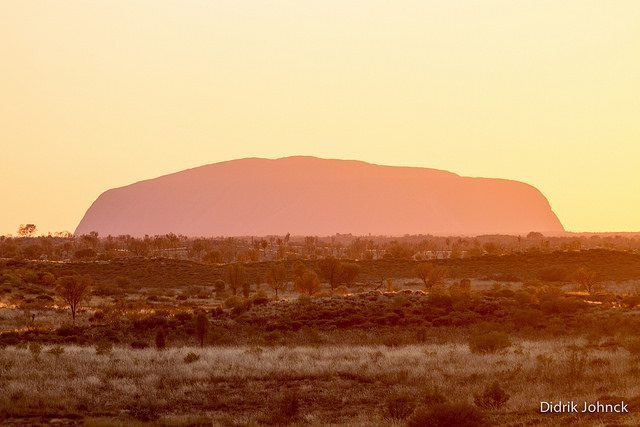
The rendition is all from an aerial perspective, as though seen from the top of Uluru, and so I ask, why should we not attempt this view? She refuses to answer, shakes her head in a scowl. Geraldine steps in, “Information and knowledge have to be earned.” I am scolded to be in the real time of art creation.
Then she moves under an awning and spreads a large parchment on a flat surface. A traveling easel salesman would not do well here. Alice proceeds to create a new piece, this filled with pointillist renderings and ideograms. I ask the meaning, and she gives vague references to singing the universe into being in a tryst of cosmopoiesis. She references Creation Time, songlines, dreamtime and totem animals.
Later, I am told that the dot painting is a method to hide the real meaning of the Aborigine art from outsiders, from the uninitiated. Visitors are just given a children’s level of detail. No obol to Charon could get me across this river. The art here is in the unknown.
As the evening light rakes across the bush, I head over to a place called TaliWiru (beautiful dune), which, with a backdrop of Uluru (almost anywhere you go for kilometers in any direction offers a backdrop of Uluru), serves up a table d’hote four-course dinner that spills into the starry darkness.
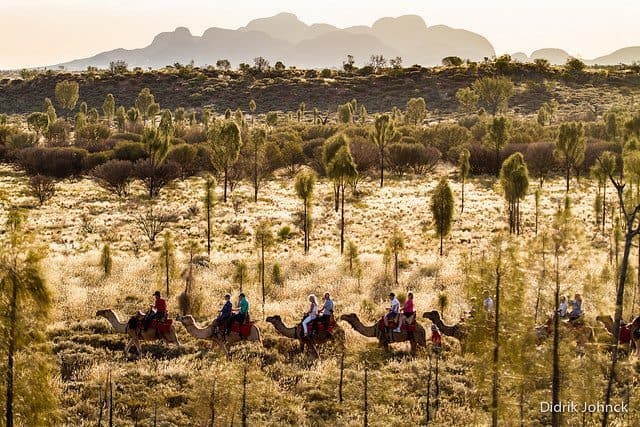
The menu includes such as native thyme and garlic grilled darling downs wagyu fillet, wattleseed rubbed kangaroo carpaccio, bunya nut, and shallot crusted polenta fondant and bush yogurt foam, all paired with fine Australian wines.
A Waiter with a Laser Pointer
Between the main courses and dessert, a waiter appears with a laser pointer and travels the sky, from the Southern Cross to Scorpio to Orion, all riding beneath the dense swath of the Milky Way.
Then we retire to a campfire and listen to the dulcet tones of a didgeridoo, which sounds not unlike the raspberry blowing I did at school, but with a trace of melody.
Up again insanely early the morning next for the benediction view, sunrise over Uluru. Even though there are hundreds at the viewing site, I feel this is Earth’s first dawn. I always assumed Peter Lik used filters for his brilliant photos of The Rock, but no need, it appears.
No dye, no tint, no coat of thin blood could make this scene more vivid. It is so dunning it precipitates mad ideas of ascension, pulling my thoughts upwards into spirals. Who could resist?
As with many mountains, there is a summit book to sign. But this register, near the base of Uluru, is for those who choose to not make the climb. I sign with a strained flourish.
The Edge of Mutitjulu
Denni Russell is my guide, a superbly knowledgeable escort, and she leads me to the edge of Mutitjulu Waterhole, a semi-permanent watercourse nestled in the contours of Uluru. The water looks so cool and inviting as the day heats up, and I have this lust to strip and jump in for a splash. But Denni instructs this, too, is sacred, no swimming allowed, so again, the art is in the not-doing.
Some things are sanctioned, however. I spend an hour at the town square lawn re-learning to fling a curved stick. I had forgotten how to throw a boomerang…but it came back to me.
Boomerang Practice
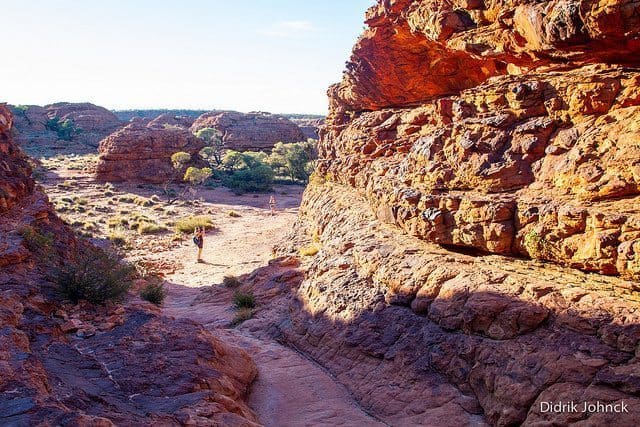
Actually, we learn that the boomerangs here do not come back. In the coastal areas, the Aborigines devised a larger version with different aerodynamics so that the weapon, after clipping a bird, would not be lost in the water. Here, though, with the vast vacant landscape, there is no need for a return….just accuracy at 140/kilometers an hour to bring down a running supper.
The bush boomerangs are made from mulga, a hardwood acacia, and have as many uses as a Veg-O-Matic. You can scratch your back, make a fire, make music, employ as a cooking implement, a ceremonial object, a message stick, and you can hunt. A thought that works up an appetite.
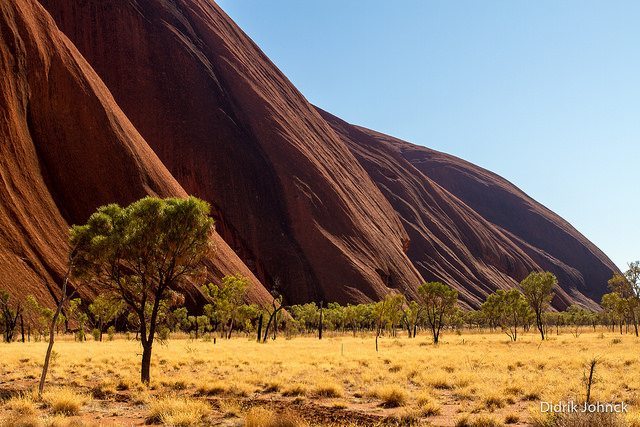
I lunch in town, at Geckos, next to an Asian eatery with my favorite local name, “Ayer’s Wok.” As with most of the food here, it is tucker to table or paddock to plate, and I dig into an Outback Pizza smothered with smoked kangaroo and emu strips.
Afterward I sit down to watch the Wakagetti Dancers, who stage an animated performance that mimics various animals the Aborigines hunt in the Bush.
Inviting the Audience to Dance
Then they invite audience members to give it a go, and what looks noble, graceful and realistic when the Aborigines swoop and swirl, looks a little campy when we westerners attempt, but also undeniably fun.
So much of the Aboriginal interface is about not doing, curbing curiosity and transit, that it seems incumbent to do something in the Western sphere.
Blaise Pascal said in The Pensées, “Our nature lives in movement; complete calm is death”…and so, I hop on a Harley with Uluru Motorcycle Tours, and unpack the thrill of rebel speed as we slice the warm air while an orange rim smolders the wide horizon. No doubt, there is a tension between spirit and speed here, as I can barely repress a yen to roar the bike overland towards the base of The Rock.
Nonetheless, I am not doing that.
That night it’s a self-cook indoor grill at the Pioneer Outback BBQ, a favorite among locals. Looking around the low-lit hall I think, for a fleeting moment, I’m in a cellar full of giant mushrooms. Virtually everyone inside is wearing a slouch hat; many the distinctive fur Akubra. It reminds me of my dad’s era, in post-war America when every middle-class man wore a wide-brimmed hat out of the house.
Local Kangaroo, Emu, and Camel
They wink at me, four locally-sourced sausages, kangaroo, emu, crocodile, and camel (the four food groups of The Outback), and a Wagyu rump steak, which I sizzle to well-done and then consume with two glasses of “150 Lashes” pale ale and awesome live music from Marc Lawson, the airport ground handler. By the time I get up to leave my belly is shaking like pudding.
The sky the next day is smooth, translucent, like the belly of a frog. I decide to make my way towards Alice Springs, capital of the Outback. It’s a five-hour drive, a wink and a nod for locals…some will effort the distance to see a movie…but I decided to break it up with visits to Curtain Springs Station and Kings Canyon, the Grand Canyon of Australia.
Million Acre Cattle Station
Curtain Springs is a privately-owned million-plus-acre cattle station, anchored by one of those desert roadhouses that prides itself in its eccentricity. It sells bags of animal scat, (bull, kangaroo, wild horse, gecko, rabbit, camel, and emu…all that’s missing, says the packaging, is “political bull shit–the bags are not big enough.”
Ballooning Over the Outback
Up at 4 am this time, and for good reason. Am joining Outback Ballooning for a dawn flight over the Outback. On the bus to the launch site, the metal music is blasting, intended to shake us awake. “Is that “Stairway to Heaven?” I ask, eyelids still half-mast.’
“Are you kidding? Led Zeppelin is the one group banned on a balloon trip,” the driver rebukes.
Flapping my sides in the crisp night air of the desert I watch as the crew inflates the balloon, using flames to grow the long, flaccid silk dangle to something of size and splendor. When swollen to full, I jump into the airship along with captain and crew, and off we sail, just as the first rays of day shatter the horizon. Peering down it looks like a giant broom has swept away all the topography.
For as far as I can see in three directions it is stony, dead flat, and summoning, like drums just out of sight. There are no fences against possibility in sight; only an endless promise. In the other direction, I can see the cardboard scenery of the MacDonnell Ranges, and some odd-looking man-made domes, which I am told is a top-secret American submarine base.
Eggs in a Flying Basket
Gliding along there is an ineluctable sensation of being unhinged, our bodies eggs in a flying basket. With the burner’s warmth pressing against my eyelids, the breeze is a cool, feminine hand over a throbbing forehead; the earth below curves to a vanishing point in tier upon tier of rubicund-brown.
It’s all too beautiful hovering over the Red Center of the Northern Territory. I have to do nothing, except look down and around and admire. Effortlessly the balloon carries me to unexpected places. This is the high art of not-doing, and I plan to simply hold on as the envelope just keeps on sailing, second star to the right, and straight on till Dreamtime.
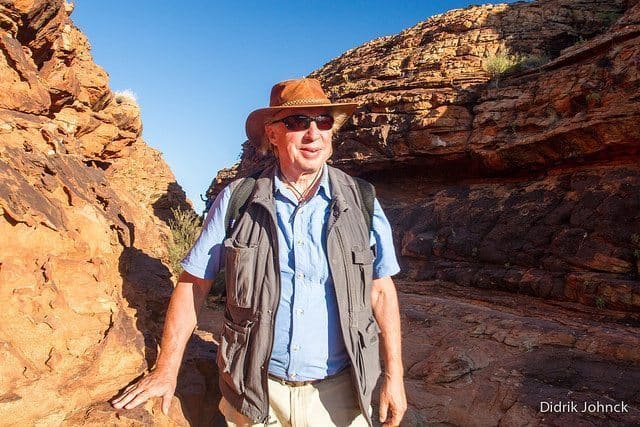
Richard Bangs travels the world and shares his top notch videos on YouTube. Read more of his stories on GoNOMAD.
- Valentine’s Day Suggestions…for that Special Person - January 22, 2026
- Missouri Sports Travel Adventure: From Landmarks to Ballparks - January 21, 2026
- What First-Time Visitors Get Wrong About Visiting Iceland - January 15, 2026


